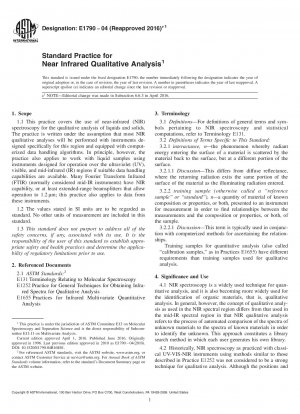ASTM E1790-04(2016)e1
Standard Practice for Near Infrared Qualitative Analysis
- Standard No.
- ASTM E1790-04(2016)e1
- Release Date
- 2004
- Published By
- American Society for Testing and Materials (ASTM)
- Latest
- ASTM E1790-04(2016)e1
- Scope
4.1 NIR spectroscopy is a widely used technique for quantitative analysis, and it is also becoming more widely used for the identification of organic materials, that is, qualitative analysis. In general, however, the concept of qualitative analysis as used in the NIR spectral region differs from that used in the mid-IR spectral region in that NIR qualitative analysis refers to the process of automated comparison of the spectra of unknown materials to the spectra of known materials in order to identify the unknown. This approach constitutes a library search method in which each user generates his own library.
4.2 Historically, NIR spectroscopy as practiced with classical UV-VIS-NIR instruments using methods similar to those described in Practice E1252 was not considered to be a strong technique for qualitative analysis. Although the positions and intensities of absorption bands in specific wavelength ranges were used to confirm the presence of certain functional groups, the spectra were not considered to be specific enough to allow unequivocal identification of unknown materials. A few important libraries of NIR spectra were developed for qualitative purposes, but the lack of suitable data handling facilities limited the scope of qualitative analysis severely. Furthermore, earlier work was limited almost entirely to liquid samples.
4.3 Currently, the mid-IR procedure of deducing the structure of an unknown material by method of analysis of the locations, strengths, and positional shifts of individual absorption bands is generally not used in the NIR.
4.4 With the development of specialized NIR instruments and mathematical algorithms for treating the data, it became possible to obtain a wealth of information from NIR spectra that had hitherto gone unused. While the mathematical algorithms described in this practice can be applied to spectral data in any region, this practice describes their application to the NIR.
4.5 The application of NIR spectroscopy to qualitative analysis in the manner described is relatively new, and procedures for this application are still evolving. The application of chemometric methods to spectroscopy has limitations, and the limitations are not all defined yet since the techniques are relatively new. One area of concern to some scientists is the effect of low-level contaminants. Any analytical methodology has its detection limits, and NIR is no different in this regard, but neither would we expect it to be any worse. Since the relatively broad character of NIR bands makes it unlikely that a contaminant would not overlap any of the measured wavelengths, the question would only be one of degree: whether a given amount of contaminant could be detected. The user must be aware of the probable contaminants he is liable to run into and account for the possibility of this occurring, perhaps by including deliberately contaminated samples in the training set.
1.1 This practice covers the use of near-infrared (NIR) spectroscopy for the qualitative analysis of liquids and solids. The practice is written under the assumption that most NIR qualitative analyses will be performed with instruments designed specifically for this region and equipped with computerized data handling algorithms. In principle, however, the practice also applies to work with liquid samples using instrumen......
ASTM E1790-04(2016)e1 Referenced Document
- ASTM E1252 Standard Practice for General Techniques for Obtaining Infrared Spectra for Qualitative Analysis
- ASTM E131 Standard Definitions of Terms and Symbols Relating to Molecular Spectroscopy
- ASTM E1655 Standard Practices for Infrared Multivariate Quantitative Analysis*, 2024-04-20 Update
ASTM E1790-04(2016)e1 history
- 2004 ASTM E1790-04(2016)e1 Standard Practice for Near Infrared Qualitative Analysis
- 2004 ASTM E1790-04(2010) Standard Practice for Near Infrared Qualitative Analysis
- 2004 ASTM E1790-04 Standard Practice for Near Infrared Qualitative Analysis
- 2000 ASTM E1790-00 Standard Practice for Near Infrared Qualitative Analysis

Copyright ©2024 All Rights Reserved